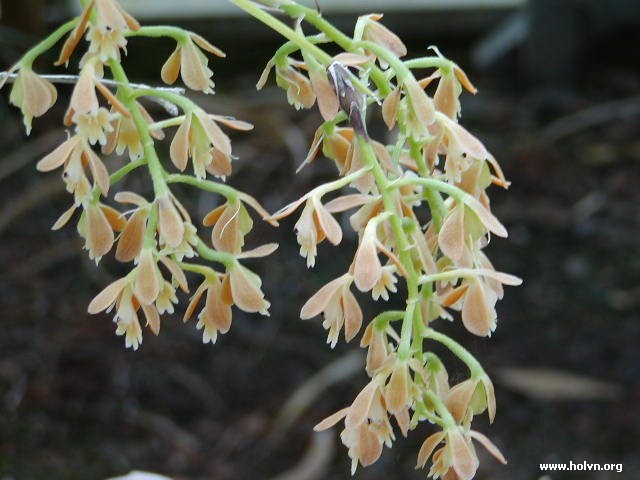

Epidendrum tuxtlense Hágsater, García-Cruz & L.Sánchez 1999 GROUP Anceps SUBGROUP Polyanthum
Photo by holvn.org website
Photos by © Weyman Bussey


 LATE
LATE through EARLY
through EARLY 
Common Name The Tuxtla Epidendrum [San Andres de Tuxtla A region of Vera Cruz, a state in southern Mexico]
Flower Size .4" [1 cm]
Found in Vera Cruz and Oaxaca states of Mexico on the gulf slope in tropical montane, deciduous and rain forests at elevations of 1300 to 1700 as a medium to giant sized, cool growing epiphyte with simple, basally terete, mid way laterally compressed, cane-like stems enveloped completely by old leafless sheaths and carrying in the upper half, 5 to 18, sub-coriaceous, narrowly elliptic to lanceolate, shortly acuminate, basally clasping leaves articulate to the sheaths that blooms in the late spring through early fall on a terminal, pluri-racemose, compact and dense, many flowered inflorescence that can rebloom over the years and carrying 20 to 32, simultaneously opening seminally fragrant flowers.
"Epidendrum tuxtlense belongs to the GROUP Anceps which is recognized by the simple stems, generally elongate, compound racemose inflorescence producing new successive racemes with time, fleshy flowers, filiform to narrowly spatulate petals, and the SUBGROUP Polyanthum which has elongate, not sub-corymbose racemes. The species is recognized by its stems, ancipitose towards their apical half, compact and dense racemes, smaller flowers, with seminal fragrance. Similar to E. polyanthum which has terete stems, elongate and lax racemes, larger flowers, lateral lobes of the lip with a small sinus in the margin. Epidendrum stallforthianum Kraenzl. has an elongate and lax raceme, longer and brownish flowers, a disagreeable fragrance, lateral lobes of the lip semiovate." Hagsater etal 1999
Synonyms
ReferencesW3 Tropicos, Kew Monocot list , IPNI ; * Icones Orchidacearum 3 Plate 390 Hagsater & Soto 1999 drawing fide; Icones Orchidacearum 11 Plate 1162 Hagsater 2008 see recognition section; Icones Orchidacearum Vol 11 Plate 1181 Hagsater & Sanchez 2008; Icones Orchidacearum Vol 11 Plate 1196 Hagsater & Sanchez 2008 see recognition section; Icones Orchidacearum 13 Plate 1355 Hagsater 2010 see recognition section
--------------------------------------------------------------------------------------------------------------------------